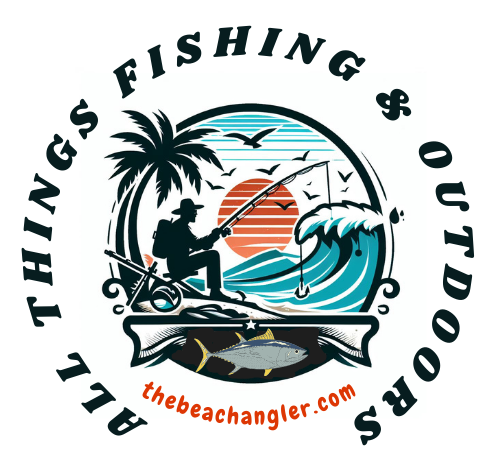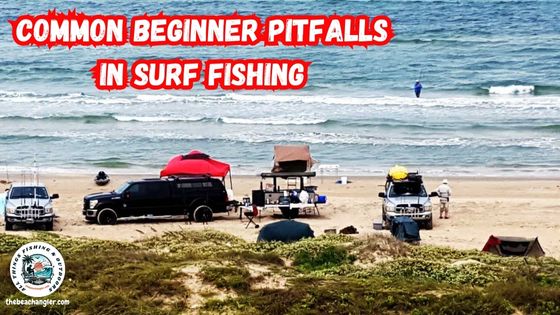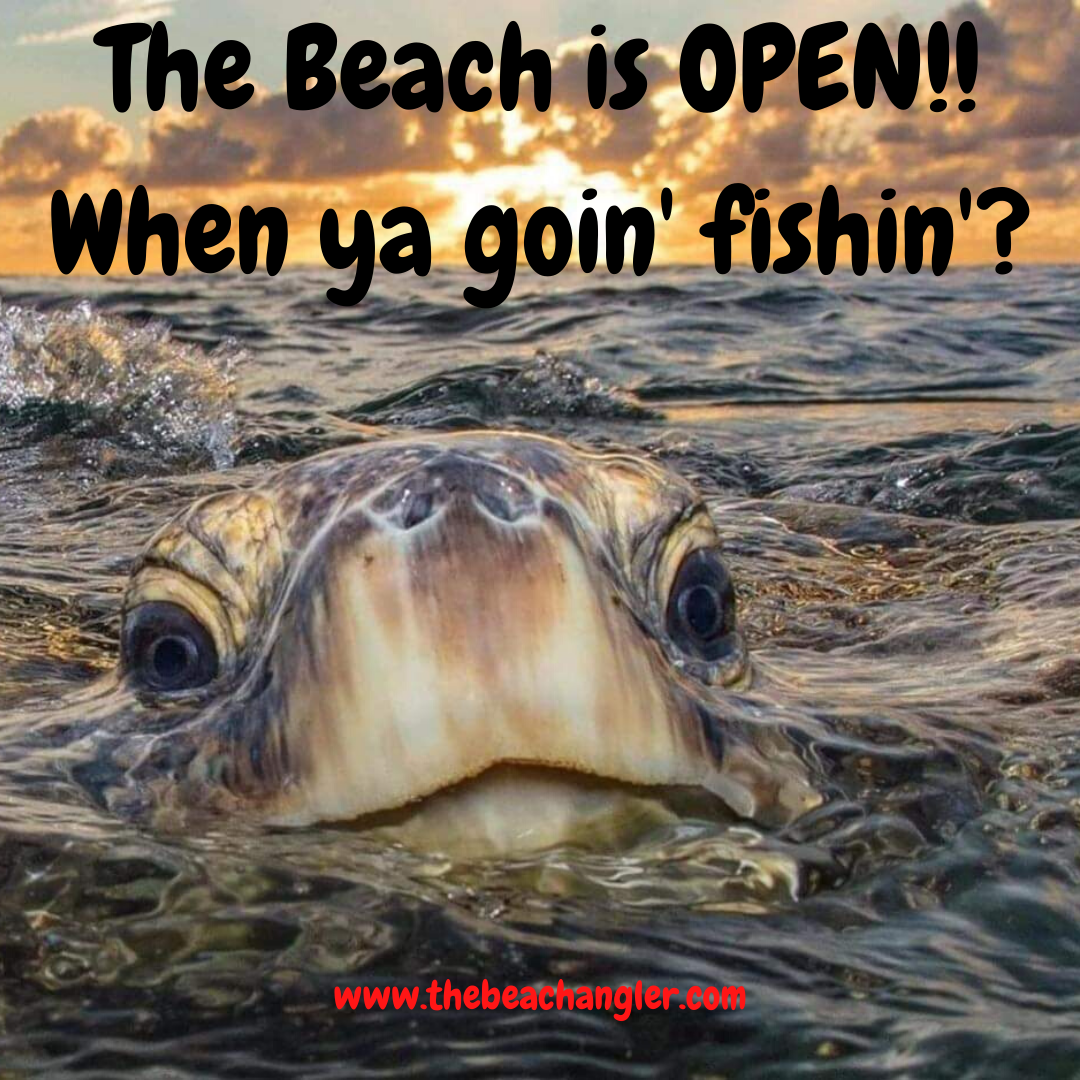There are some common pitfalls in surf fishing for beginners that you should try to avoid. Grabbing the right gear can make or break your surf fishing adventure. First off, it’s about finding a reliable surf fishing rod and reel. These aren’t just any rods; you need ones that can handle the challenges saltwater conditions throw at you. Think sturdiness and durability. Long-lasting equipment not only saves you some bucks in the long run but can also jack up your fishing game.
QUICK LOOK 7 Pitfalls in Surf Fishing for Beginners
- Timing – One thing I’ve learned about surf fishing is that timing really is everything. You could have the best gear and the right location, but if you’re fishing at the wrong time, you might as well be casting into a desert.
- Weather – When you’re planning a surf fishing trip, ignoring the weather is like setting out to sea without a compass – it can lead to a whole lot of nothing or put you in a bit of a pickle.
- Where to Fish – Finding a prime fishing spot isn’t just about luck; it’s about knowing the lay of the land, or in this case, the surf. Before you even consider casting, spend a bit of time scouting your location.
- Baits and Rigs – Getting your bait and rigging straight can mean the difference between landing a catch and telling stories about the one that got away. Let’s be real; fish are picky. You can’t just throw any old bait out there and expect magic.
- Casting Technique – Having a great casting technique is crucial when it comes to reaching those fish hanging out beyond the breakers. It’s not just about distance; accuracy plays a huge role too, especially when you’re targeting a specific spot.
- Patience – Fishing has a way of testing anyone’s patience. You might find yourself casting over and over with nothing to show for it, and that’s when it’s easy to throw in the towel. Staying patient, though, is what sets successful anglers apart.
- Following the Rules – Following the rules isn’t just a good idea; it’s necessary to protect both the environment and yourself. Every area has its own set of fishing laws that you need to be aware of before you hit the surf.
Now, let’s chat about size. Ever heard of going too big or too small? It’s real. The length and weight of your rod should match the type of fish you’re aiming for. A mismatch here and you’re either overpowered or under-equipped. And when I say quality, I mean materials too. Corrosion-resistant materials help keep your gear in top shape, especially that reel, which takes quite the beating from the salt.
You might be tempted to cut costs with some cheap tackle. Trust me; that’s not the play here. Affordable doesn’t mean bottom shelf. There are plenty of decent mid-range options that’ll provide the bang for your buck without selling your success short.
It’s also wise to think about surf fishing tackle. Having a set that’s made to withstand the surf is going to be your ally in the long run. Consider upgrading your tackle box with essentials tailored for surf conditions, like weights that hold in the current and hooks that are sharp enough to handle the tougher mouths of saltwater fish.
In the end, the right gear is like your fishing wingman. It won’t guarantee you a catch, but it’ll sure give you a fighting chance. Armed with the proper equipment, you’re well on your way to overcoming that first beginner’s pitfall.
Surf Fishing for Beginners – Timing is Everything
A very common question I get when it comes to surf fishing for beginners, is what is the best time for surf fishing. One thing I’ve learned about surf fishing is that timing really is everything. You could have the best gear and the right location, but if you’re fishing at the wrong time, you might as well be casting into a desert. Understanding when to fish can massively boost your chances of success, and it’s tied to some tried-and-true natural phenomena.
- The tides are your first big clue. They affect how fish behave, where they move, and even what they eat. Typically, the periods just before and after high tide are popular playing times for fish. The incoming tide often brings baitfish closer to shore, and the predators follow them in.
- Then there’s the moon’s influence. Phases like the full moon or new moon increase tidal activities, which can make fish more active. This doesn’t mean you should only fish during these times, but working around them can offer a leg up. Keep an eye on a lunar calendar next time you’re planning your trip.
- Don’t forget about the time of day either. Dawn and dusk are generally golden hours for fishing. Fish are naturally more active around these hours, taking advantage of the lower light to hunt for food. Midday sun, on the other hand, can sometimes put them off feeding altogether.
- Oh, and seasons matter, too. Each season has its own tidal patterns and fish activity shifts. Get familiar with what’s likely to be happening at your preferred spot depending on the time of year.
By paying attention to these factors, you’re setting yourself up for a more productive day on the water. It’s not just about when you can be there; it’s about when the fish are there too.
Surf Fishing for Beginners -Respect Weather and Water Conditions
When you’re planning a surf fishing trip, ignoring the weather is like setting out to sea without a compass – it can lead to a whole lot of nothing or put you in a bit of a pickle. Weather conditions greatly influence fish behavior, and not paying attention can turn your day into a washout.
Fishing when conditions are unfavorable can be risky and, let’s face it, quite unproductive. Safety should always come first. Before heading out, check reliable weather forecasts. Consider wind strength and direction as these can affect casting and fish activity. Strong offshore winds might seem good for your cast, but they can make retrieving tough and even dangerous.
Also, pay attention to water conditions. Is there a strong current? Is the water choppy? These factors can affect both the fish and your own footing. Think about the clarity of the water as well; clearer water can mean fish are more skittish.
Storms are the big no-go here. They can pop up unexpectedly and turn what looked like a promising day into a dangerous one. A sunny morning can quickly flip to a stormy afternoon, especially in coastal areas where weather shifts happen fast. If a storm is forecast or appears suddenly, pack it in and try another day.
Understanding the interplay between fish, water, and weather will make your fishing trip more fruitful and keep you safer. Sometimes, the best decision is to wait for the right conditions rather than force a potentially hazardous outing.
Surf Fishing for Beginners – Scout Before Casting Out
Finding a prime fishing spot isn’t just about luck; it’s about knowing the lay of the land, or in this case, the surf. Before you even consider casting, spend a bit of time scouting your location.
- You’re not just looking for a random sandy stretch; you’re searching for structures like jetties, sandbars, and troughs where fish love to congregate.
- Baitfish movement is a sight that can’t be ignored. Look for places they might be hanging out, like near rock formations or grassy areas along the shore. Birds diving can tip you off to baitfish presence too, and where there’s baitfish, predatory fish aren’t far behind.
- Use a topographic map or even satellite images before heading out to get a lay of the surf’s landscape. Apps and local knowledge can also provide a real edge, showing hot spots where fish are known to frequent. These tools are great at finding those hidden gems of the shoreline.
- When you’ve got a shortlist of potential spots, spend a few minutes observing. Is there a rip current or eddy that looks promising? These areas often trap food and attract fish, creating natural feeding grounds. Seasoned anglers will tell you, that picking the right spot is worth the extra thinking upfront.
- Engaging with locals can pay dividends too. Every beach has its secrets, and getting to know them can save you a lot of frustration. Experienced anglers often have the low-down on where to find the best bites, especially if you’re new to the area.
Surf Fishing for Beginners – Mastering Bait and Rigging Techniques
- The choice of bait largely comes down to what you’re targeting. Live bait like sandworms or shrimp is often a go-to because it’s what fish naturally go after. Freshness matters here. If you’re using cut bait, make sure it’s not past its prime. On the flip side, artificial lures can also do wonders if used right. They can imitate the movement and color of the natural prey, which can be super attractive to fish.
- The rigging part is where things can get technical but also exciting. Different rigs suit different situations and fish types. If you’re after bottom dwellers, a fish-finder rig might be your best bet. For fish cruising higher in the water column, consider a float rig. Learning these setups comes with practice, so don’t get discouraged if you’re not a pro from the get-go.
- Your bait presentation should look as natural as possible. It’s all about making the fish believe that the bait is part of their normal diet. This might mean adjusting how the bait is hooked or even adding a bit of weight to help it sit right in the water.
- Last but not least, keep experimenting with different baits and rigs. Fish often change preferences based on a range of factors like water temperature and season. Keep notes of what works and when so you can refine your strategy over time.
Surf Fishing for Beginners – Perfecting Your Casting Technique
Having a great casting technique is crucial when it comes to reaching those fish hanging out beyond the breakers. It’s not just about distance; accuracy plays a huge role too, especially when you’re targeting a specific spot.
To enhance your casting performance, you’ll want to focus on the mechanics. Start with your stance – feet shoulder-width apart for balance. Grip the rod firmly but not too tight. Remember, it’s about finesse, not brute force. A smooth, consistent motion is key to achieving that perfect cast.
When it comes to the actual act of casting, aim for fluidity. Begin with a backswing that doesn’t go too far back, then accelerate smoothly forward, releasing the line just as the rod tip points towards the target. An abrupt motion can not only shorten your cast but also scare away any fish nearby.
Keep practicing with different weights and sizes of lures to get a feel for how they affect your cast. Wind conditions can also challenge your technique, causing your line to drift off course. Adjust your angle and momentum based on the breeze; sometimes compensating with an overcast can make all the difference.
Mastering casting in various conditions takes time but practice makes perfect. Take note of what works for you in different settings, and don’t hesitate to make incremental adjustments. Over time, your accuracy and distance will improve, turning casting into almost a second-nature skill.
Remember, it’s not just about reaching farther. It’s about putting your bait or lure in exactly the right place, at the right time, for the best chance of enticing a bite.
Surf Fishing for Beginners – Cultivating Patience and Perseverance
Fishing has a way of testing anyone’s patience. You might find yourself casting over and over with nothing to show for it, and that’s when it’s easy to throw in the towel. Staying patient, though, is what sets successful anglers apart.
Patience in fishing means watching and waiting, using any pause to reassess your strategy. Sometimes it involves trying different baits or altering your location slightly. Even seasoned fishers will tell you, that switching things up a bit now and then can lead to surprising results.
It’s also about enjoying the process, not just the catch. Take in the surroundings, the sound of the waves, and the thrill of the unknown. Patience is about the journey, each cast offering a new potential and new experience.
Perseverance means sticking with it even when the fish aren’t biting. It might involve learning when to rest and when to push harder, balancing effort with enjoyment. Keep your line in the water because the moment you step away might just be the moment a fish strikes.
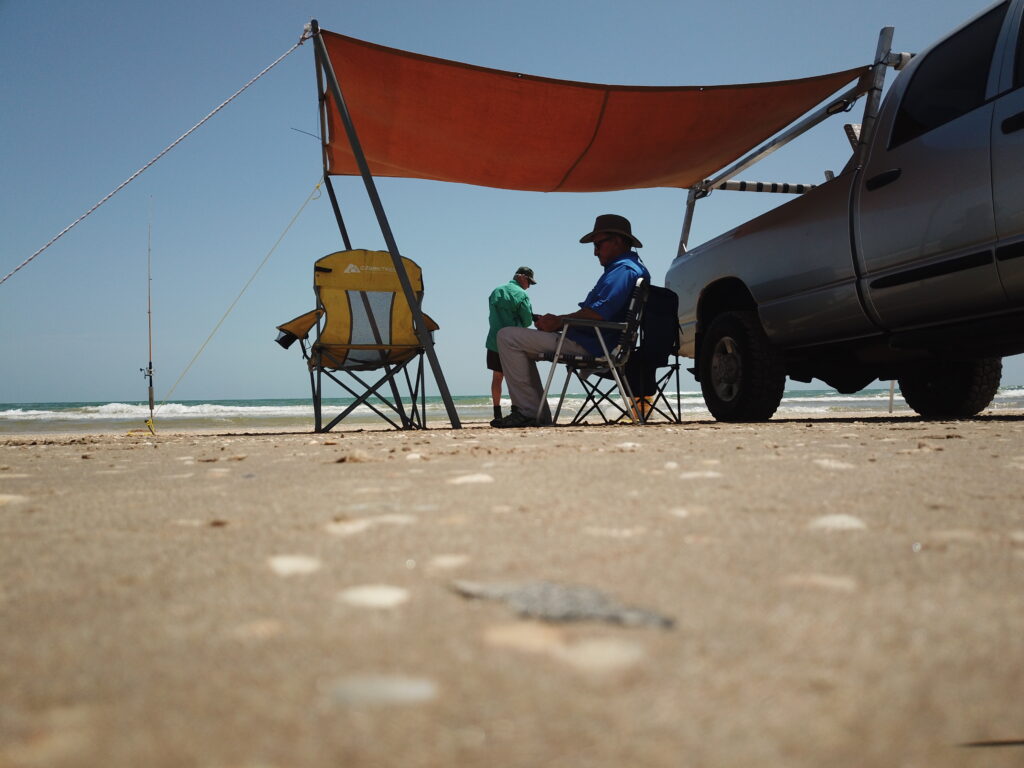
Embrace the learning curve each session offers. Keep track of your successes and slip-ups in a journal. By understanding what doesn’t work, you’ll adapt and grow for future trips. A true fisherman values patience and perseverance alongside skill and knowledge, knowing that one good day can make up for the challenging ones.
Surf Fishing for Beginners – Adhering to Local Regulations and Safety
Following the rules isn’t just a good idea; it’s necessary to protect both the environment and yourself. Every area has its own set of fishing laws that you need to be aware of before you hit the surf. These can include size limits, bag limits, and even specific seasons for different types of fish.
Apart from keeping you on the right side of the law, understanding these regulations helps conserve fish populations, ensuring that there are plenty of fish for future anglers, too. Pick up any required permits or licenses for the area ahead of time. They’re often available online or at local tackle shops.
Possibly the most important detail of surf fishing for beginners is don’t overlook personal safety, either. Surf fishing environments can be unpredictable, with tides and waves changing rapidly, sometimes catching you off guard. It’s wise to wear a personal flotation device, and always keep an eye on the ocean’s rhythm. Keeping a safe distance from the water and knowing your physical limits can prevent risky situations.
Another safety measure is using proper footwear to protect against sharp rocks, shells, or even marine life like jellyfish. These might not seem like deal-breakers until you’re facing a regretful situation without the right gear. Fishing with a buddy, too, adds an extra layer of security in case something unexpected happens.
Regular checks on equipment and gear for wear and tear can also avert accidents before they happen. This means checking knots, lines, and other tackle elements for signs of wear that could fail under pressure.
By respecting regulations and adopting safety measures, you’re all set to not only follow the rules but enjoy a rewarding and safe fishing experience.
Check Out Our Latest Articles:
- 5 Features The Z-Man HerculeZ Swimbait
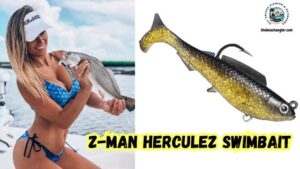
- 7 Tips for Fishing Gulf Of Mexico Nearshore Rigs In Texas

- 6 Top Features of Okuma Hakai Baitcast Reels
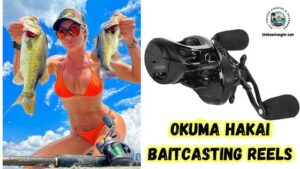
- The Daiwa Lazy Fashad

- Fishing For Pacific Coast Rockfish and the Challenges they Present

- Z-Man Big BallerZ

As always, stay safe, enjoy the journey and please try to leave it cleaner than you found it. If you have any comments, questions, ideas, or suggestions please leave them in the comment section below and I’ll get back to you ASAP. You can follow us on Facebook: Rex The Beach Angler, Instagram: thebeachangler7, Twitter: @AnglerBeach, and YouTube: Man Art Creations.
P.S. – Thanks so much for checking out our blog we really appreciate it. Just so you know, we may receive a commission if you click on some of the links that appear on our site. This helps us keep our content free and up-to-date for everyone. We appreciate your support!
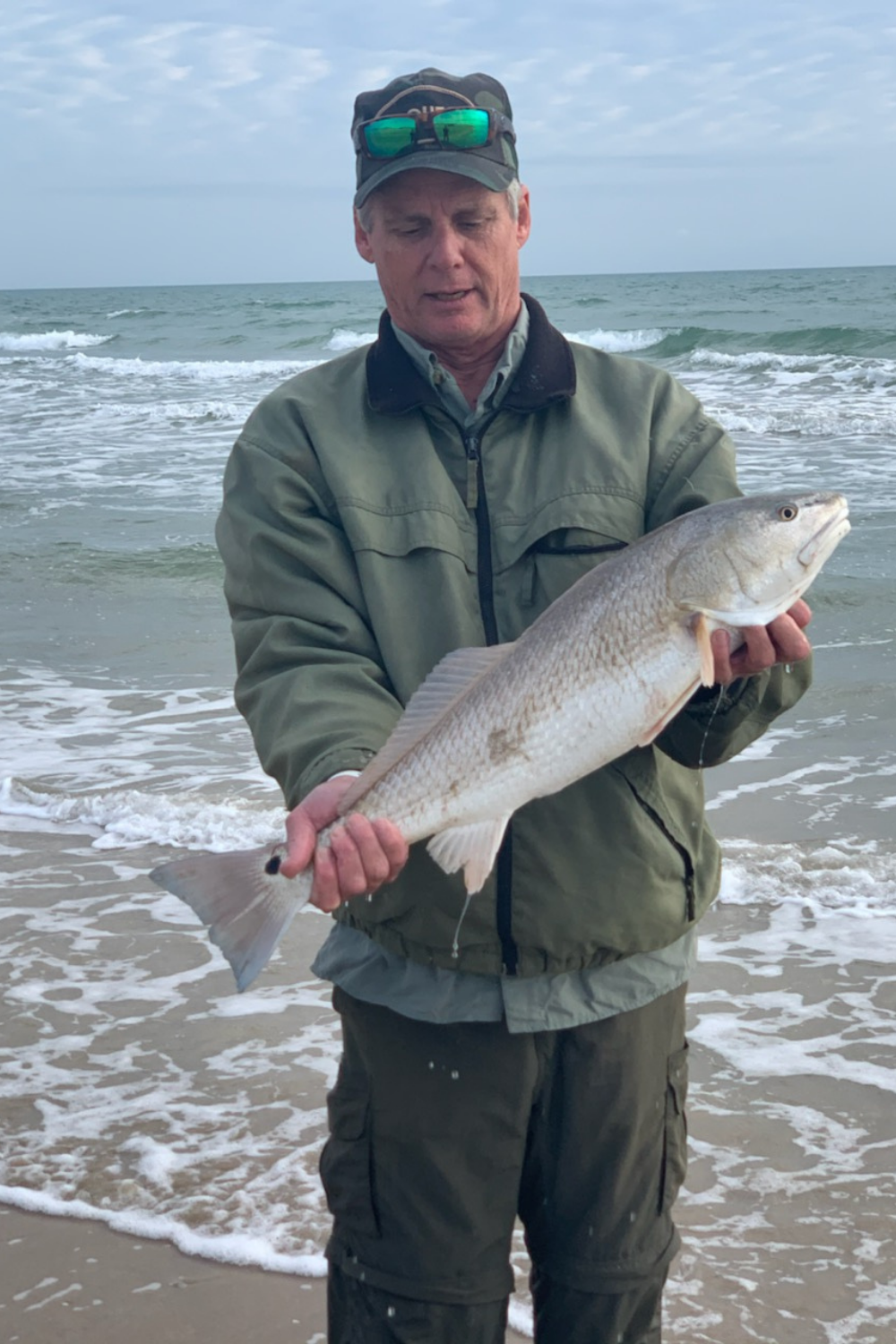
A life long surf fisherman with 50+ years of experience, I am also an avid hunter and outdoorsman. I will be sharing my passion for the outdoors with you so be prepared for hunting, fishing, camping, hiking and more. Along with gear reviews and the latest trends and innovations in the outdoor industry.
